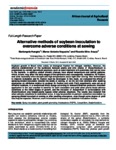Por favor, use este identificador para citar o enlazar este ítem:
http://www.alice.cnptia.embrapa.br/alice/handle/doc/1018244Registro completo de metadatos
| Campo DC | Valor | Lengua/Idioma |
|---|---|---|
| dc.contributor.author | HUNGRIA, M. | pt_BR |
| dc.contributor.author | NOGUEIRA, M. A. | pt_BR |
| dc.contributor.author | ARAUJO, R. S. | pt_BR |
| dc.date.accessioned | 2015-06-22T11:11:11Z | pt_BR |
| dc.date.available | 2015-06-22T11:11:11Z | pt_BR |
| dc.date.created | 2015-06-22 | pt_BR |
| dc.date.issued | 2015 | pt_BR |
| dc.identifier.citation | African Journal of Agricultural Research, v. 10, n. 23, p. 2329-2338, Jun. 2015. | pt_BR |
| dc.identifier.issn | 1991-637X | pt_BR |
| dc.identifier.uri | http://www.alice.cnptia.embrapa.br/alice/handle/doc/1018244 | pt_BR |
| dc.description | Soybean growth in Brazil relies solely on biological fixation for nitrogen nutrition, However, the effective establishment of the symbiosis between plants and elite strains of Bradyrhizobium is jeopardized by current agricultural practices, such as seed treatment with pesticides that can be toxic to the bacteria. In addition, global climatic changes have altered temperature and rainfall patterns, which, in turn, may affect the early stages of the symbiosis and, consequently, nodulation, N2 fixation, and yield, especially when drought and high temperatures occur right after sowing. New technologies to improve nodulation and N2 fixation must be developed. In this study, we evaluated the effects of spraying diluted inoculants towards the seeds at sowing, or on the soil-root interface after seedling emergence on attributes relative to soybean N2 fixation and yield. Field experiments were set up at different locations, in a randomized block design according to standard Brazilian protocols. Inoculant application in the soil resulted in benefits for both nodulation and yield when plants faced adverse conditions at the initial stages of growth, and the inclusion of Azospirillum in co-inoculation with Bradyrhizobium also helped plants bypass initial adverse situations. The results also revealed that when adverse situations to nodulation occur, it may be possible to perform corrective inoculation by spraying diluted inoculant at sowing or after seedling emergence, even though some degree of yield loss may be expected. However, more information is necessary to establish inoculation frames. | pt_BR |
| dc.language.iso | eng | eng |
| dc.rights | openAccess | eng |
| dc.title | Alternative methods of soybean inoculation to overcome adverse conditions at sowing. | pt_BR |
| dc.type | Artigo de periódico | pt_BR |
| dc.date.updated | 2017-05-11T11:11:11Z | pt_BR |
| dc.subject.thesagro | Soja | pt_BR |
| dc.subject.thesagro | Inoculante | pt_BR |
| dc.subject.thesagro | Fixação de nitrogênio | pt_BR |
| dc.subject.nalthesaurus | Soybeans | pt_BR |
| dc.subject.nalthesaurus | Nitrogen fixation | pt_BR |
| riaa.ainfo.id | 1018244 | pt_BR |
| riaa.ainfo.lastupdate | 2017-05-11 | pt_BR |
| dc.identifier.doi | 10.5897/AJAR2014.8687 | pt_BR |
| dc.contributor.institution | MARIANGELA HUNGRIA DA CUNHA, CNPSO; MARCO ANTONIO NOGUEIRA, CNPSO; RICARDO SILVA ARAUJO, TOTAL BIOTECNOLOGIA INDÚSTRIA E COMÉRCIO LTDA. | pt_BR |
| Aparece en las colecciones: | Artigo em periódico indexado (CNPSO)  | |
Ficheros en este ítem:
| Fichero | Descripción | Tamaño | Formato | |
|---|---|---|---|---|
| Alternativemethodsofsoybeaninoculationto.pdf | 435,59 kB | Adobe PDF |  Visualizar/Abrir |









